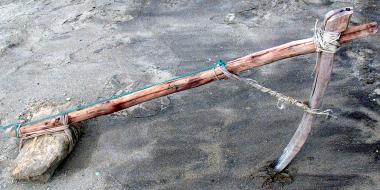
Local Indonesian anchor - we've come a long way
Anchors
This is a HUGE topic, so it will probably evolve with time. We're not going to try to pick the best anchor, but we'll try to indicate how various types of anchors will perform in different conditions. We'll also give our opinions on related gear and anchoring techniques - mostly what works for us. For now we've included information on the following topics:
Anchoring Scope:
We've actually watched a French guy on a powerboat literally throw his anchor overboard,
wait until it hit the bottom, put out a bit more rope, tie it off (without
testing it) and then hit the bars on the beach. Obviously, this is totally
inadequate, as well as being extremely dangerous to boats anchored nearby (and
we were directly behind this nitwit).
 Local Indonesian anchor - we've come a long way |
When anchoring, you want to know not just how deep the water is, but how far it is from the bottom to where your anchor rode (rope or chain) comes onto the boat (usually the bow). Scope is defined as how much rode is out, and is expressed in multiples of that distance. For instance, 4:1 scope is 4 times the distance from the bottom to the bow, NOT just from the bottom to the surface!
Anchors are designed such that pulling them horizontally will make them dig in deeper, while pulling on them vertically will pull them out. The critical angle of pull, where it goes from digging in to pulling out, is usually around 13° from horizontal, or a scope of about 4.5:1, but that number is very different for different anchors. In general, a shallower angle will work better, so you want as much scope as you can, commensurate with not annoying your neighbors by swinging all over the anchorage. After all, your anchor chain isn't doing you any good sitting in your anchor locker.
The books usually say that when using rope you should use at least 6:1 scope, and 10:1 if you're expecting bad weather. In the '80s, we tended to use 10:1 all the time, and more if we were expecting trouble. But we're pretty conservative in our anchoring.
When anchoring on all chain, the books say that 3:1 or 4:1 scope is adequate, as the heavy chain will not form a straight line to your anchor but will instead form a curve, so the pull on the anchor itself will be almost horizontal. Perhaps so, but we generally put out at least 5:1 for routine anchoring, and more like 7:1 if we're expecting more than 20 knots of wind.
Chain or Rope?:
Some very light (or very cheap) boats tie a rope to their anchor and call it
good, but we've never liked that. Our first boat,
Oriental Lady,
was very light and couldn't take much weight in the bows, but we still had at
least a boat‑length of chain on each of our 3 anchors before we went to (much
lighter) rope.
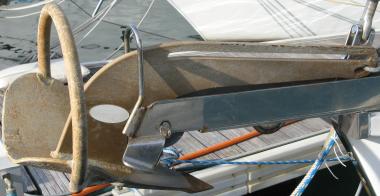 Manson Supreme anchor - similar to the Rocna but with a slot to facilitate recovering it in rock or coral |
Chain is heavier than rope, which can be both good and bad. It's heavy to carry around, but it's better at keeping your boat in one place. Chain is much more expensive than rope, and galvanized chain has to be re‑galvanized (or replaced) every few years, but it feeds through a windlass all by itself, while rope has to be tailed and then manually fed down the deck‑pipe.
Another advantage of chain is that it resists abrasion. Tying a rope directly to the anchor means that the rope will be lying on the bottom, exposed to all sorts of sharp edges that can cut the rope easily. When we used rope and chain on Lady, we clipped a float to the last link of chain, to lift it a few feet off the bottom in an attempt to limit abrasion damage to the rope.
Even so, we once anchored Lady in Rodney Bay, St. Lucia, which we knew from earlier visits to have a beautiful sand bottom. Imagine our surprise a few days later when Lady started sailing blithely out the bay! It turned out that an earlier storm had shifted some sand and uncovered some old, dead coral. Our anchor rope had wrapped around some and been quickly cut by the sharp coral. (What was really frightening was that we'd been off the boat in town all the previous day!)
One of the problems with anchoring on rope is that it's so light that it won't hold you in position if the wind dies. Instead, your boat will be at the whim of any stray currents, wandering all over your anchoring circle and possibly annoying your neighbors. Using all chain avoids that, as the chain is heavy enough that it will usually keep your boat in position unless the winds or currents are pretty strong.
Basically, if you can afford the weight and cost, anchoring on all chain usually works better than using rope.
Number of Anchors to Carry:
In our opinion, a well found cruising boat will carry at least 3 anchors, of at
least 2 different types. Monohulls, which are not as weight‑conscious as
we multihulls, will often carry more, just to be safe, as more is usually
better. If possible, 2 anchors should go on the bow, ready to deploy
instantly, although putting that much chain and anchor weight out at the bows will make
some boats tend to "hobby‑horse" under choppy conditions.
Boats that "Med‑moor" sometimes carry an anchor (and winch!) in the stern, so they can drop it on the way in and then go bow‑to the dock or wall. This affords much greater control when mooring, as well as providing much more privacy, since the cockpit and salon are no longer open to perusal by everyone passing by.
Anchor Swivels:
We carry a galvanized anchor swivel for special occasions, but we've never
actually used it. We're not big fans of them ever since the catamaran
anchored in front of us in the
Tobago Cays pulled the stainless steel of his
swivel apart like cheese in only 20 knots of wind. It didn't snap, it just
pulled apart (at 11pm, of course). In our opinion, anchor swivels only
need to be used if you're going to be leaving your boat for an extended period
anchored in either an area where tidal currents swing the boat in circles
everyday, or if you're anchored on multiple anchors all brought to a single
point (like a Bahamnian moor).
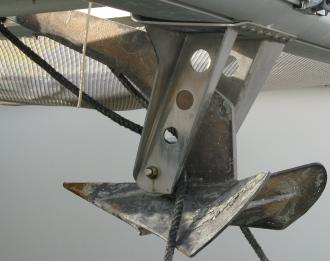 Well used Delta under a catamaran cross‑arm Note the light‑weight bridle ropes coming up. |
Chain can lose a LOT of strength if you hockle it up by twisting it too much. Also, a chain that's all twisted up will often jump out of the chain‑gypsy on the anchor winch. Therefore, you want to keep the twists out of the chain as much as possible, but you don't need an anchor swivel to do that. About once a year you can flake your chain out on the dock of a marina and get all the twists out of it. Even retrieving your anchor from a deep anchorage will let you get the twists out of it if you first let all the chain out and then bring it back in slowly and with particular care, letting it unwind as it comes up.
Snubbers:
In normal winds, chain will tend to hang in a curve (or catenary). But if
the wind is strong enough, or if you get in a surge, you can certainly straighten out that
chain, no matter how heavy it is. The resulting snatch on the anchor can jerk it
out very easily, even if you've got good scope out. So the prudent mariner
will attach a rope or rubber snubber from their bow to their chain, and let out enough chain
that the snubber takes the anchoring loads. This will soften the jerk on the anchor
if conditions straighten out the chain.
Bridles:
Multihulls, both cats and tri's, tend to sail around at anchor. If they're
not pointing dead into the wind, it gets between their hulls and off they go,
first in one direction and then in the other. To stop this tendency,
attach ropes from your outer bows to your anchor chain (usually with a
chain‑hook) and make sure those
ropes take the anchoring loads. This bridle moves the anchoring effort out
in front of the boat, which keeps it head to wind and prevents it from sailing
around. It has the beneficial side effect of acting as an excellent snubber.
Note that you don't want your bridle to be too strong. When we bought Ocelot, her bridle was made of 14mm double‑braided Dacron. This is quite strong but it has almost no stretch at all, which defeats the snubbing effect of the bridle. Once we anchored where there was a bit of surge and sure enough, the bridle exploded with a sound like a rifle shot (and we had friends on board with young kids). We replaced the strong 14mm double‑braided bridle with some nice, stretchy, 1/2" (12mm) 3 strand nylon. This bridle lasted for years before ultraviolet degradation made us replace it with an identical bridle.
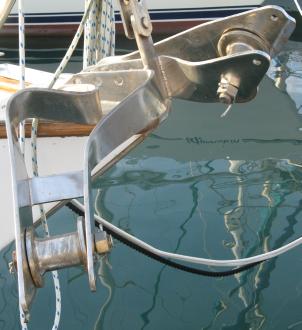 Bent bow-rollers from a caught anchor |
Also, make sure to NOT let the chain‑hook hit the bottom. If the bridle is too long and the chain‑hook can lie on the bottom, it can let go of the anchor chain. In shallow water, we wrap our bridle around our bollards once or twice to keep the chain‑hook always off the bottom. We've also now lashed a loop of bungee cord to the hook, to make it hang onto the chain better.
Bowsprits:
We've never owned a boat with a bowsprit so we can't speak from personal
experience here but it's pretty obvious that the bobstay will chafe against the
anchor rode unless something is done. Many boats sheath their bobstays in
plastic pipe, which certainly helps. Most boats with bowsprits have their
anchor rollers part way along their bowsprits, not right at the stem. The
further forward the anchor is tethered, the better the boat will lie to the
wind. But a bowsprit is also considerably weaker than the stem, so putting
the anchor rollers too far out will make them too weak and they can break.
If an anchor gets caught under a coral head on short scope and then even a small
swell comes up under the boat, the incredible loads can easily bend or break
gear.
We've often wondered why more boats with bobstays don't connect their lower bobstay tang to their snubber line, like the photo below right. The forces are in a different direction, so the bobstay tang may need to be reinforced, but it seems an excellent way to improve anchoring scope, as now the rode is only coming up to the surface of the water instead of all the way to the bow. OK, you really don't want that tang to fail, but we'd think it could be beefed up sufficiently.
 Snubber line coming from a bobstay tang |
Transits:
When anchoring and moving at very slow speeds (fractions of a knot) it's often
very difficult to tell if the boat (anchor) is moving. Our trick is to
look for something relatively close by and to the side of us superimposed
against something far away. A church steeple or even a big tree on shore
against a distant hillside often works very well. If the object in the
foreground moves relative to the background, you're moving. The closer the
close object is the better, as the relative movement will be apparent sooner.
Of course, the obvious close, pointy object next to you when you're anchoring is
usually another sailboat mast. These aren't ideal, as that boat could well
be drifting back and forth on its anchor and thus disturb your readings, but if
there's little or no wind and nothing else around, a neighbors mast often works
well enough. This method works to tell you if the anchor is dragging when
you're setting the anchor, and it also works to tell when the boat changes from
moving forward to moving backwards, so you know when to start lowering the
anchor.
Your GPS will also give you Speed Over the Ground (SOG) and it will usually display down to hundredths of a knot (X.xx). But if you're moving slightly sideways then that will be added to your SOG and make it appear you're dragging, even if you're not actually moving backwards at all. Also, remember that your GPS doesn't actually receive SOG directly from the satellite. It has to work out those SOG numbers by looking at consecutive positions. Since a shipboard WAAS compliant GPS is typically only repeatable to about 10' (3m), those slow SOG numbers aren't all that accurate, and should be taken with a grain of salt.
Hand signals:
Back in the '80s, when cruising in the Virgin Islands (with all the bare‑boat
charterers) we used to make sure we got into an anchorage early. We'd pick
up the deck, make sure everything was ship‑shape, pour ourselves a cold one, and
then sit back and watch the poor bare‑boaters try to anchor. They didn't have a clue,
and watching them try was sometimes pretty entertaining. They'd drop their
anchors while still going forward, then pull them clear across the bay, pick
them up, and repeat the whole thing.
Usually Ma was on the bow while Pa was at the controls. Since the controls were directly above the engine, Pa couldn't hear what Ma was saying. So then Ma would shout louder, which caused Pa to respond equally loudly. But without the engine noise, Ma thought Pa was shouting in anger, and the whole thing would escalate and snowball into a flaming argument which could be heard clear across the anchorage.
In the '80's we learned some simple hand signals which have helped us avoid those screamed consultations while anchoring. Sue doesn't like the controls as much, so she's usually on the anchor while Jon drives (although we trade off now and then so we each know how to help the other person). When Sue claps her hands together vertically and them pulls them apart, she's asking "what's our depth?" Jon can respond in a calm voice because he knows Sue has no ambient noise around her, so she'll hear easily. Like many cats, Ocelot's engines are insulated and fairly far from the helm, but most monohulls have more engine noise at the helm.
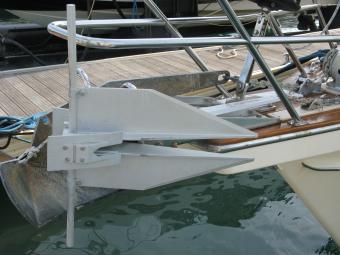 Danforth-type anchors can be hard to stow |
When we're setting the anchor, Sue will stand on the taught chain, feeling for what the anchor is doing. She'll also look for a transit so she can tell if Ocelot's moving, as it's often very difficult to tell. If the anchor is dragging or walking along the bottom, she'll hold her hand out and waggle it from side to side so Jon knows to back off with the engines. If the anchor isn't moving, she'll give a "Thumbs up" so Jon knows to continue bringing up the engine revs.
Anchoring:
When approaching an anchorage, we'll both talk about where we think we want
to anchor. Where the best protection is, what will happen if the wind
shifts, and where there might be a suitable hole amongst the other anchored
boats. Then Sue (usually) will go to the bow and make sure the anchor winch is
working. Jon can speak in normal tones and Sue will
hear him easily, but Sue tries to use only hand signals as it
can be difficult to hear at the helm over the engine noise.
Polarized sunglasses cut surface reflections amazingly so we both wear them to help us see into the water. Sue can see the bottom much better from the bow so if the bottom is patchy sand and rock then she chooses the best sandy place to drop. Jon is usually checking out distances to other boats to make sure we won't get too close to anyone. On final approach Jon will say "In Reverse, 25 [or whatever] feet deep" and Sue will quickly find a transit to tell when Ocelot starts going astern so she can start lowering the anchor. Usually we let the anchor down by releasing the clutch, as it's faster and puts less wear on the anchor winch than lowing the anchor electrically. We mark our anchor chain every 25' (8m) with both paint and tie‑wraps (colored electrical cable‑ties) so we can tell how much chain we have out. Sue will add 4' of freeboard to the depth reported by Jon and let out at least 5 times that amount of chain.
Once an adequate scope has been let out Sue will secure the windlass, put
her foot on the chain, put her fist out to start signaling, and watch her
transit as Jon starts pulling backwards to set the anchor. Jon
brings the engine revs up slowly as Sue signals what's happening with the
anchor. If it's holding, Sue signals with thumbs up, but if it's
dragging she puts her hand out flat and waggles it back and forth. Once
both engines are at about 2,000 rpm Jon will say "that's power" and both
of us will watch transits (and the GPS) to make sure we don't move for 30 seconds.
Then Jon will reduce power as Sue catches the chain with the chain‑hook
on the bridle and we let out chain until the bridle is taking the anchor strain.
Thirty seconds with both engines at 2,000 rpm without moving may sound
a bit excessive for setting the anchor, but we like waking up where we went to
sleep. ![]()
Finally, we'll usually dive on the anchor to make sure that it's set correctly. We can't always do this - many anchorages are just too murky to see very far - but we much prefer to make that final check that everything's OK. And a swim is usually an excellent end to a nice days sail.
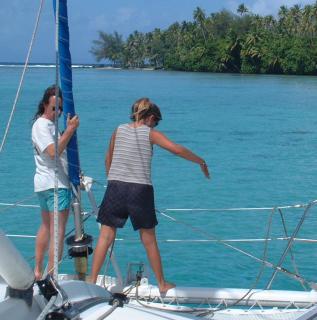 Amanda pointing to the anchor for the helm |
Anchor Retrieval:
If there's nobody around we sometimes practice sailing off our anchor but
usually we use our engines to come up on our anchor. The anchor winch is
strong enough to pull Ocelot forward, but that puts unnecessary wear on the
winch. We usually have a reasonable idea of where we dropped the anchor so
we'll motor slowly in that direction, start pulling up the anchor, and release
the bridle. The person on the bow signals the helm by pointing where the
anchor chain is, so the helm knows which direction to steer. When we're
directly over the anchor the person on the bow makes a fist and pulls it down
sharply, telling the helm to break the anchor out by running forward with the
engines.
Sometimes the wind has shifted dramatically while we've been at anchor. If there are coral heads around, the anchor chain can get wrapped around and under them, making it very difficult to retrieve. In these situations, it's handy to have a teenager around to dive in and report on where the anchor and chain are. In Tahanea, Chris reported that our chain went around several coral heads in a big loop, went under Ocelot(!) and was lying about 65' (20m) off our port side! Then he worked out a system of signals where the helm watched his left hand for which way to go while the the person controlling the anchor winch watched his right hand to know when to raise or lower the chain. It was an interesting exercise and worked very well. After a night of high winds and squalls where nobody got any sleep (and one boat parted their anchor chain and another destroyed their anchor chocks) we were the first boat that could leave. (OK, having 2 engines really helped!)
Anchor Buoys:
Tying a floating line to the back of the anchor and putting a float on the line
can help you retrieve the anchor if it gets stuck under something. Most
anchors have a release point for such a line, positioned such that the anchor
should release whatever it's stuck under when pulled from there. We very
seldom use an anchor buoy, as we usually feel they're more trouble than they're
worth. Too many small boats go whizzing around without watching where
they're going too
closely, and if one picks up our trip‑line in his propeller he could easily
un‑set our anchor. Also, it's difficult to keep the trip‑line from getting
caught in our own propellers when we're retrieving the anchor.
In Penang, Malaysia, we anchored in an area known to have a foul bottom (the alternative was having to listen to loud rock music until 4am). People had mentioned that boats that anchored there sometimes had to retrieve their anchors with scuba gear after it got caught on something. So we decided to put a buoyed trip‑line on our anchor. Problem was that there's quite a current there so we were pulling on our anchor in many different directions. Eventually our own chain got caught up in the trip‑line and tripped our anchor! We were standing on a marina dock around the corner and were very surprised to see Ocelot floating along all on her own! It took us over an hour to untangle everything and it reinforced our decision to stay away from anchor buoys if we could.
|
|||||||||||||||||||||||||||||||||||||||||||||||||
Anchor Performance Matrix:
These are our opinions of how these anchors perform on different bottoms.
These data are relative to each other, as no anchors really do well in grass or
coral. Of course, nobody likes anchoring in coral at all - it damages the
beautiful coral and it wears the galvanizing off both chains and anchors.
These data reflect how we've observed these anchors to perform overall. For instance, once a Danforth anchor is set, it will usually hold very well, but getting a Danforth to set in, say, grass or hard sand can be quite difficult. Rock bottoms are extremely hard to get an anchor to stick in, and a Fisherman is probably the best anchor in rock.
Ordering here is not based on how well these anchors seem to perform but on how many of them we see on blue‑water cruising boats - that is, popularity amongst those of us who have to trust our lives and our boats to our ground tackle.
When choosing an anchor, it's a good idea to put it on the ground, on it's side, and slip a finger underneath the point. Lift the point with your finger and try to gauge how much force it takes. This is the force that will start the point digging into the bottom, and the more force it takes to lift the point and the sharper that point is, the better the anchor will dig in.
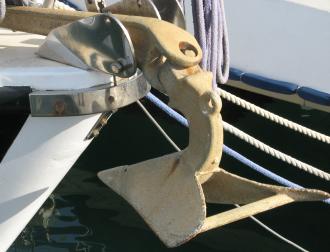 Genuine CQR 45 - note worn hinge-pin |
Plow‑type Anchors:
These are probably the most common types of anchors on world cruising boats.
Typical brand names are CQR (for "Secure" - it has a swivel at the base of the shank) and
Delta,
which is solid and doesn't have a swivel. Both are now apparently sold by
Lewmar. Many companies
manufacture knock‑offs of these anchors, but be very careful what you buy.
The angles used in construction are critical, and many good‑looking knock‑offs
actually don't set or hold very well. Both Delta and CQR are very
mature designs and they're well
respected, so it's probably best to go with the genuine articles. We've
used a 45 lb (20 kg) CQR as our primary anchor for about 15 years, and if set
properly, it very seldom drags. Sometimes it requires some patience (i.e.
multiple attempts) to get
it to set correctly, but once set you can sleep peacefully. The only
problems we've had with our CQR was when we tried to deploy it in soft sand or mud,
and it would sometimes plow rather than set. In recent head‑to‑head anchor
performance tests, the solid‑shank Delta‑type usually out‑perform the
swiveling CQR‑type anchors by a slim margin.
 A copy of a Bruce anchor |
Claw-type Anchors:
Claw‑type anchors were started when the
Bruce anchor appeared
several years ago, but Bruce charged pretty high prices. Now that the patent has
run out there are a bunch of copy‑cats producing these anchors (including Lewmar) so
prices are more reasonable. We've never owned one so our information is second‑hand,
but they're extremely popular. Their relatively blunt points make it hard for them
to dig through grass or hard‑packed bottoms, but most anchors have problems in grass.
In virtually all other types of bottoms they do quite well. Claws hold well
in coral, but sometimes almost too well, as they can easily get stuck and be
difficult to retrieve. Strangely, claw type anchors have not done that well in recent head‑to‑head
anchor performance tests. We're not sure why this is.
Danforth-type Anchors:
Danforth
type anchors have 2 wide flukes that move up and down together on each
side of the central shank. Common brand names include
Fortress (which
makes them in aluminum) and Brittany. Virtually all ships and large yachts use this general
type of anchor. The wide flukes make for a lot of surface area, so these
anchors have tremendous holding power once they dig in, but their
relatively light tip‑weight and shallow initial digging angle can make it
difficult to get them to dig in. They're
excellent anchors in mud or sand as long as the direction of pull doesn't change
significantly, but these anchors don't turn well once they're set - If you
try hard enough, you're likely to bend something.
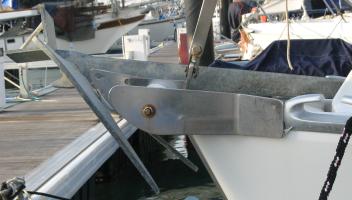 Bent Brittany was probably caught under a rock |
Danforth‑type anchors also don't do well in coral or big rocks. In coral, their wide flukes can easily get stuck under a coral‑head. Then, when you're trying to retrieve it and you're on short scope, if a swell makes up under you, the anchor can easily be bent. Other anchors can be prone to this sort of thing as well (our CQR shank was bent for years) but Danforth‑type anchors are especially susceptible.
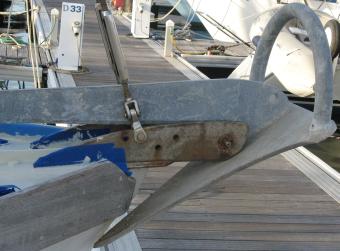 Bugel anchor - a dragon's tooth with a roll-bar |
New Toothed Anchors:
OK, this is our name for the new crop of anchors coming out that look a
bit like a single dragon's tooth welded to a solid shank, usually with a roll
bar over the back of the tooth to make it roll over and dig into the bottom. This
type of anchor includes the German Bugel (Wasi),
the Rocna and
Manson Supreme from New Zealand, the
Spade from
France, the Sarca
from Australia, Oceane, Sword, etc. An interesting comparison of these
anchors is posted at
Blue Water Supplies. We don't happen to agree with their rating as
we've seen a Spade folded up like a pretzel when its hollow(!) shank failed, but
it's an interesting (if biased) comparison.
These types of anchors are still very expensive (we paid $700 in 2009 for a 55 lb or 25 kg Rocna) because they're so new that they're still protected from copy‑cats by patent laws. But I suspect that once the patents run out there will be lots of copies coming out and prices will fall, as these anchors are obviously very easy to make. Since the Bugel's were one of the first of this type to come out, copies of it are already available. The others in this genre appear to be refinements on the Bugel's simple and elegant design.
This type of anchor has usually done extremely well in recent head‑to‑head anchor performance tests, and their popularity amongst world cruising boats is growing rapidly. They work well in real‑life conditions, not just in someone's sandbox. We have friends who absolutely swear by their Rocna - one of the reasons we bought ours. Their roll‑bar makes them roll over so their point is always poised to dig in when they're dropped. Their relatively heavy tip‑weight and sharp points makes them dig in and set quickly, and if anything trips them they'll reset quickly as well. Their design also handles changes in direction well, as they can pivot on their tooth relatively easily, often without unsetting the point, just rotating it. Their main issue, as far as we can see, is that they have noticeably less surface area relative to other anchors of the same weight. Rocna's answer to this? Buy a bigger anchor. But for us weight‑conscious multihulls, that's not a nice option.
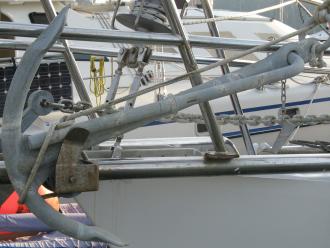 Fisherman anchor folded for stowage |
Fisherman-type Anchors:
The Fisherman is the type of anchor that most folks think of when someone says
"anchor" - a straight crossbar at the top connected by a shank to a pair of curved
hooks at 90° to the crossbar at the bottom. The crossbar generally folds
parallel to the shank to facilitate storing. The Fisherman design is so
old that lots of companies manufacture it under a variety of titles. Fisherman anchors will grab
onto any little crack and usually handle coral, rock and grass better than Plow or Danforth or
Claw type anchors. But their small tips have little surface area so they
don't do well in soft bottoms. Therefore, most Fisherman anchors we see
are used as secondary or coral anchors.
What we use:
On Oriental Lady
in the '80s we used a 45 lb (20 kg) CQR
as our primary anchor. In 7 years
of cruising, I think this anchor dragged perhaps 4 times, and one of those was
in a hurricane (and it didn't drag far). Our storm anchor was a 65 lb (30 kg) cast
Danforth.
It was a bit of a monster, but Jon could manhandle it where he needed it from
the dinghy. Our secondary anchor was a 28 lb (13 kg) Fisherman.
It stowed down our port ama happily enough when it was folded, and
it was quick to deploy if we found ourselves drifting towards some rocks, or if
we wanted to pull ourselves around to face the swell. All anchors had
their own lengths of chain already attached, but usually only about 50' (15m).
Lady was only 5 tons and she had rounded bottoms, so she tended to hobby horse,
and this was exacerbated by weight in the ends. In fact, even on a
day‑sail between islands, Jon would usually unshackle our main anchor and stow
it down the windward ama. After the chain we went to 3‑strand nylon, 1/2"
(12mm) on the smaller two anchors and a bit bigger on the storm anchor. We
usually clipped a fishing float (about the size of 2 fists) to the last link of
chain. This would lift the end of the chain and, more importantly, the end
of the rope, about 1‑2 feet (0.5m) off the bottom, thereby minimizing abrasion.
 25kg Rocna - simple, elegant, & getting more popular |
On Ocelot, we also used a 45 lb (20 kg) CQR as our primary anchor until 2009. This anchor generally worked very well, even with a slightly bent shank. I only recall it dragging when we deployed it in soft mud, but it sometimes required multiple attempts to get it to set correctly, and it was probably a bit small for Ocelot.
In September 2010 we took possession of our new 55 lb (25 kg) Rocna anchor. The anchor tests we've seen on the Rocna seem to be very good and friends with this anchor simply rave about it, saying it sets instantly, and will instantly re‑set if something pulls it out or the wind shifts. As of this writing (Nov 2010) we haven't had much experience with our Rocna, but it's never failed to set, even when dropped onto extremely foul bottoms. Once we had to cut 4 separate 12mm ropes off the anchor (plus some other junk) when we retrieved it, but it hadn't dragged. Quite impressive.
For our primary anchor we carry 80 meters (265') of 10mm galvanized chain, running through a Lofrans Tigres 1,000 watt horizontal axis anchor windlass. Over the years we've had to replace the chain in Panama (2003) and in Malaysia (2006), and we've had it regalvanized in December 2009 in Penang, and again in 2014 in Phuket. Sometimes I wish we'd just bought stainless steel chain in St. Martin where it was cheap, but stainless steel does have some strange failure modes that galvanized chain isn't prone to. Out here in the boonies we can't usually get fancy proof‑coil or high‑tensile chain. About the best we can do is to make sure that the galvanizing is hot‑dipped (not plated, which is shiny), that it fits in our chain‑gypsy, and that the links aren't stuck together by the galvanizing.
We built our bridle by tying a thimble into the middle of a 50' (15m) length of 1/2" (12mm) nylon line with a doubled figure‑8 knot, shackling a stainless steel chain‑hook to the thimble, and fastening the ends of the bridle to a pair of custom bollards we'd installed at the very tips of our bows. When we've finished setting our anchor, we catch the chain with the chain‑hook and then let out enough chain so the bridle takes the load. Voila! Ocelot sits happily without sailing all over the anchorage.
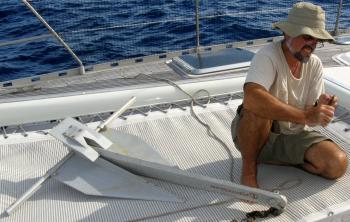 Shackling on our HUGE Fortress storm anchor |
Our secondary anchor is just what came with Ocelot when we bought her - a 35 lb (15 kg) Brittany anchor with about 65' (20 m) of 10mm (3/8") chain shackled to a couple hundred feet of 1" (24 mm) 3‑strand nylon line. This anchor isn't used very often so we don't keep it in our spare roller, but it's all flaked out in our secondary anchor locker and ready to deploy at a moment's notice. We're not big fans of Brittany anchors, but it's never failed us so we're hesitant to spend valuable money replacing it. But if a 35 lb (15 kg) claw type anchor jumped on Ocelot, it would probably get the secondary anchor job.
Our storm anchor is a monster Fortress FX‑125. This anchor is proof‑positive that some things should not be bought over the internet. When we bought Ocelot from SunSail in 2001, we knew she wouldn't come with a storm anchor so we went looking for one over the internet. We wanted a Danforth‑type anchor because of their superior holding power once set, but we needed one that Jon could handle in an emergency. The Fortress FX‑125 weighs 69 lbs (31 kg) so it's only a little heavier than the 65 lb cast Danforth storm anchor we had on Oriental Lady. So we ordered one and had it sent to us in St. Maarten. But the FX‑125 is made of aluminum, and according to Fortress is as big as a steel Danforth weighing 125 lbs (57 kg)! When this monster arrived it was so huge that we couldn't stow it anywhere, even broken down! Eventually we made chocks for it on our aft deck so we can lower it into the dinghy quickly and easily. We store its 125' (40m) of 10mm chain in 2 buckets right next to it for easy deployment.
The Fortress is so big that
visitors approaching from the stern have asked us if we stole it from the Queen
Mary! ![]()
Equipment Pages:
Cruising Info:
Top Level: Home | Destinations | Cruising Info | Underwater | Boat Guests | Ocelot | Sue | Jon | Amanda | Chris | Site Map | Make a Comment
|
If our information is useful, you can help by making a donation |
Copyright © 2000‑ Contact: Jon and Sue Hacking -- HackingFamily.com, svOcelot.com. All rights reserved.